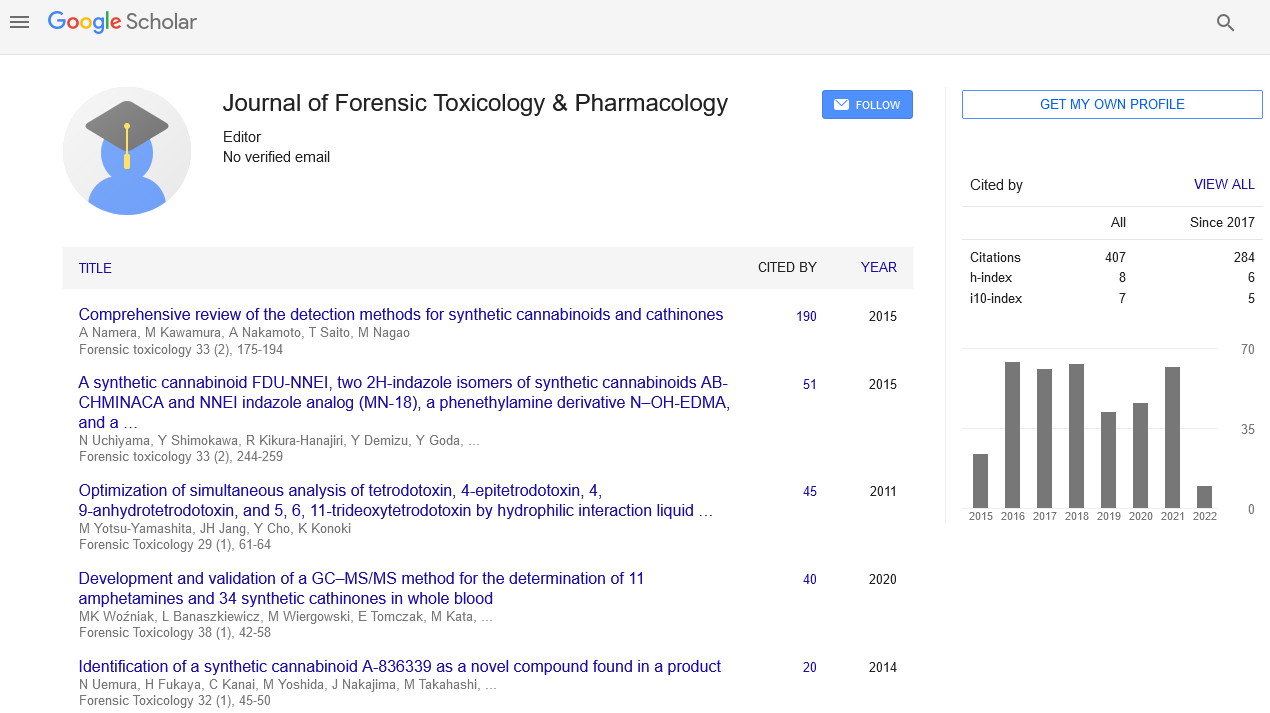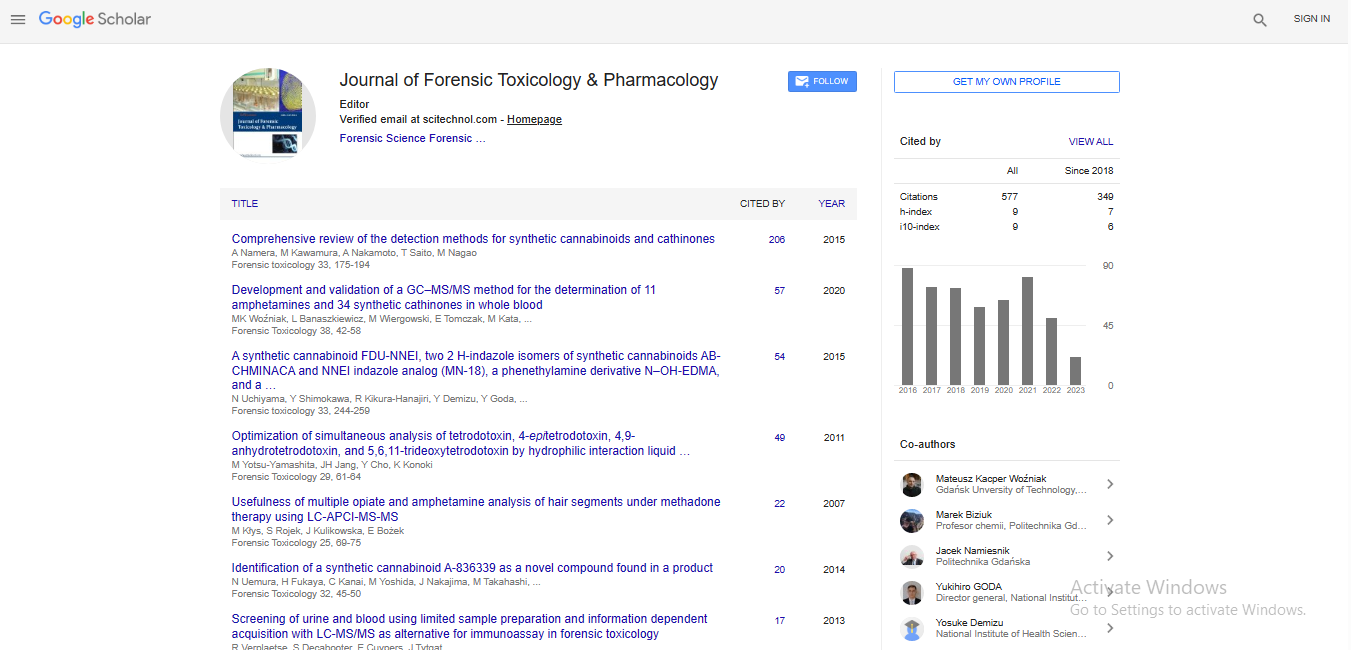Perspective, J Forensic Toxicol Pharmacol Vol: 13 Issue: 4
High-Performance Liquid Chromatography in Clinical Toxicology: Enhancing Diagnostic Precision
Monticello Shuey*
1Department of Forensic Sciences, Oslo University Hospital, Oslo, Norway
*Corresponding Author: Monticello Shuey,
Department of Forensic Sciences,
Oslo University Hospital, Oslo, Norway
E-mail: shueymonticello@gmail.com
Received date: 26 November, 2024, Manuscript No. JFTP-24-156270;
Editor assigned date: 28 November, 2024, PreQC No. JFTP-24-156270 (PQ);
Reviewed date: 12 December, 2024, QC No JFTP-24-156270
Revised date: 19 December, 2024, Manuscript No. JFTP-24-156270 (R);
Published date: 26 December, 2024, DOI: 10.4172/JFTP.1000205.
Citation: Shuey M (2024) High-Performance Liquid Chromatography in Clinical Toxicology: Enhancing Diagnostic Precision. J Forensic Toxicol Pharmacol 13:4.
Description
High-Performance Liquid Chromatography (HPLC) has become an indispensable tool in clinical toxicology, providing unparalleled precision in the detection and quantification of toxic substances. As a strong analytical technique, HPLC facilitates the separation, identification and quantification of chemical compounds in complex biological matrices, such as blood, urine and tissue samples. Its application in clinical toxicology has significantly advanced the ability to diagnose and manage toxic exposures with greater accuracy.
One of the primary advantages of HPLC is its versatility. By employing different chromatographic columns and mobile phases, HPLC can be tailored to detect a wide range of substances, including drugs, metabolites and environmental toxins. The adaptability of this technique ensures that it remains relevant across diverse toxicological investigations, from routine drug monitoring to emergency poison management.
In clinical settings, the use of HPLC often involves coupling the technique with advanced detection systems, such as Ultraviolet (UV) spectroscopy, fluorescence detection, or Mass Spectrometry (MS). This combination enhances the analytical capabilities of HPLC, allowing for the identification of compounds based on their specific chemical and physical properties. For example, HPLC-MS is particularly effective in detecting low concentration analytes, making it invaluable in cases where the toxic substance is present in trace amounts.
The role of HPLC in Therapeutic Drug Monitoring (TDM) cannot be overstated. By providing precise measurements of drug concentrations in biological samples, HPLC enables clinicians to optimize drug dosages, minimize side effects and prevent toxicity. This is especially difficult for medications with narrow therapeutic windows, such as antiepileptic drugs and immunosuppressants, where small deviations in dosage can lead to significant clinical consequences.
Emergency toxicology is another area where HPLC has proven its worth. In cases of acute poisoning, rapid and accurate identification of the toxic substance is important for effective treatment. HPLC’s ability to provide detailed compound profiles within a short time frame makes it an ideal choice for emergency diagnostic laboratories. Furthermore, advancements in Ultra-High-Performance Liquid Chromatography (UHPLC) have reduced analysis times while maintaining high resolution, further enhancing the utility of HPLC in urgent clinical scenarios.
Despite its many advantages, the implementation of HPLC in clinical toxicology is not without challenges. The technique requires significant expertise in method development, instrument maintenance and data interpretation. Additionally, the cost of HPLC equipment and consumables can be prohibitive for some laboratories, particularly in resource-limited settings. Efforts to address these challenges include the development of standardized protocols, automation of sample preparation and training programs to build technical expertise.
The future of HPLC in clinical toxicology is poised for continued innovation. Emerging trends include the integration of HPLC with Artificial Intelligence (AI) and machine learning algorithms to enhance data analysis and interpretation. These technologies have the potential to improve the accuracy and efficiency of toxicological assessments by identifying patterns and anomalies that may be overlooked by conventional methods. Furthermore, the development of portable HPLC devices aims to bring this powerful analytical technique closer to point-of-care settings, enabling on-site toxicological evaluations.
High-performance liquid chromatography has established itself as a cornerstone of clinical toxicology, offering unmatched precision and versatility in the analysis of toxic substances. Its contributions to therapeutic drug monitoring, emergency toxicology and routine diagnostics support its difficult role in safeguarding public health. As technological advancements continue to refine its capabilities, HPLC is set to remain at the lead of clinical toxicology, enhancing diagnostic precision and improving patient outcomes.
 Spanish
Spanish  Chinese
Chinese  Russian
Russian  German
German  French
French  Japanese
Japanese  Portuguese
Portuguese  Hindi
Hindi 
